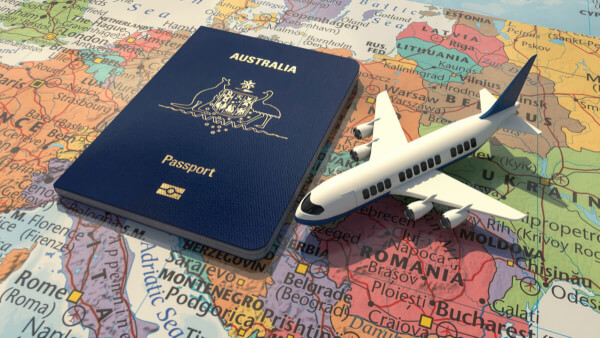Cheap Countries to Visit from Australia: Travel Destinations Reviewed
Discover budget-friendly travel from Australia! Explore cheap destinations with insights on flight, accommodation, and daily costs.

Travel insurance is an essential part of trip planning, offering protection against unexpected events during your journey. From medical emergencies to thefts and cancellations, it’s a safeguard that provides peace of mind and financial security. Some credit cards come with complimentary travel insurance, an attractive perk for avid travellers. But with that comes the question, is credit card travel insurance enough? Let’s get to the bottom of it.
This guide is going to explore how credit card travel insurance works. We’ll also let you know a little bit about Wise, a travel friendly account that helps you manage your money internationally while saving on fees.
| Table of contents |
|---|
Credit card travel insurance is a form of travel insurance coverage offered by certain credit card providers as an additional perk. It’s not something that needs to be applied for, but there generally are certain conditions that need to be met for it to be activated.
Among the Australian banks offering complimentary credit card travel insurance are ANZ, Commbank, and Westpac.
The specific requirements for activating a credit card travel insurance policy do vary, but here’s an idea of what it can include.
- The card is used to prepay for a certain amount of travel expenses like flights and accommodation
- Everyone being covered under the policy has a return ticket before leaving Australia
- The cardholder resides in Australia
- Everyone being covered is under a certain age
Some banks also require you to activate the insurance, while others consider it automatically valid as soon as you meet the eligibility criteria.
Take NAB for example, one of Australia’s leading banks. They offer complimentary travel insurance for a range of cards including the NAB Rewards Platinum Card and NAB Qantas Rewards Signature Card. Eligibility for the insurance is based on these three things.²
Due to the way it’s structured, most credit card companies won’t send you a Certificate of Insurance to prove you’re covered, like you’d receive with a stand alone policy.¹
If you need proof of insurance for your travels or to apply for a visa then you should be able to obtain it by reaching out to the credit card provider or their insurance partner and receive either a Certificate of Insurance or a Letter of Eligibility.
While coverage varies depending on the issuer, most credit card travel insurance policies will include benefits for the basic unexpected travel events.
- Medical emergencies
- Travel interruptions and cancellations
- Travel delays including allowances for meals and accommodation
- Lost or delayed baggage
- Rental car excess insurance
Unlike standard travel insurance policies, which usually only cover the named person, credit card insurance policies can often be extended to family members as well. The usual caveats for this are that they need to be the spouse or dependent children, have to meet the eligibility criteria, and a certain percentage of their journey needs to be with the cardholder.
There are also some things to be aware of that are often excluded from credit card travel insurance policies or have limited coverage.
While credit card travel insurance can be a cheap and convenient option, the stand alone policies generally provide a better level of coverage. Here’s a more in depth look at how the two compare.
| Credit Card Travel Insurance | Standalone Travel Insurance | |
|---|---|---|
| Coverage scope | Limited, often basic coverage | Comprehensive coverage often with optional extras available |
| Eligibility | Cardholder that meets the requirements of the provider | Available to anyone who’s accepted by the insurance company |
| Trip duration | Often limited to shorter trips | Can cover long-term trips |
| Cost | Included with the credit card | One-off payment made before the policy commences |
| Who’s covered | Often the cardholder plus their spouse and dependent children | The policyholders |
Going into a little more detail, let’s take a closer look at some of those points.
When deciding between the two insurance options, here’s some other factors to consider.
- Coverage for pre-existing medical conditions
- Type of travel and activities you’ll be undertaking
- How easy the claims process is
- If you’re affected by any of the policy exclusions
There’s no doubt that credit card insurance can be a useful benefit and for short, low risk trips, it might be enough. But if you’re heading away for a longer trip, have pre-existing medical conditions or are planning some adventurous experiences, then a stand alone policy is likely the better solution. This is especially true if you’re headed off on a cruise or to the snow, where credit card insurance may not cover you at all.
Something to keep in mind; if you get a stand alone policy as your primary insurance, the credit card insurance could still act as secondary insurance. This means it could cover any additional costs after the benefit limit on your primary policy has been exhausted.
Credit cards come with their perks but they are usually not the cheapest way to spend abroad due to their extra foreign transaction fee. To bring down the costs of travel when spending overseas, why not get an international debit card from Wise, to use alongside your credit card.
With the Wise card, you can enjoy low, transparent fees with the mid-market exchange rate. You can hold 40+ currencies in your account and also have some free ATM withdrawals every month to make it easier and cheaper to get cash while you’re away from home. And because it’s a debit card, you don’t need to worry about interest costs or late fees either.
No matter where you’re headed, take Wise with you, to cut the costs of your overseas spending.
Please see Terms of Use and product availability for your region or visit Wise Fees & Pricing for the most up to date pricing and fee information.
Sources used:
Sources last checked on date: 26 February 2025
*Please see terms of use and product availability for your region or visit Wise fees and pricing for the most up to date pricing and fee information.
This publication is provided for general information purposes and does not constitute legal, tax or other professional advice from Wise Payments Limited or its subsidiaries and its affiliates, and it is not intended as a substitute for obtaining advice from a financial advisor or any other professional.
We make no representations, warranties or guarantees, whether expressed or implied, that the content in the publication is accurate, complete or up to date.

Discover budget-friendly travel from Australia! Explore cheap destinations with insights on flight, accommodation, and daily costs.

Here's a list of countries you can travel to visa-free as an Australian Passport holder. We'll also add in countries that offer easy visa on arrival.